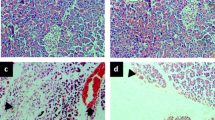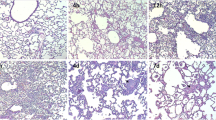Abstract
Severe acute pancreatitis represents about 20% of all pancreatitis diagnosis and it has a high mortality rate when associated with a lung dysfunction. The aim of this research was to investigate the use of a wild spectrum metabolic drug (Cytoflavin®) for the treatment of acute lung injury in experimental pancreatitis. A l-arginine-induced acute pancreatitis (groups II and III) was simulated experimentally in a rat population. A combined metabolic drug was used as treatment. We determined the levels of amylase, medium molecules (MM 254 and 280), malonic aldehyde (MA), diene conjugates (DC), interleukin-8 (IL-8), interleukin-10 (IL-10), and tumor necrosis factor-α (TNF-α) in the blood and we performed a histologic examination of the lungs and pancreas of the rat population. The activation of lipid peroxidation peaks at 24–48 h from the onset of the disease. The level of malonic aldehyde in groups II and III was higher (39.09% and 30.99%, respectively) than that in the control group I (p < 0.02; p < 0.01), the diene conjugates level was higher by 43.66% and 42.03% respectively (p < 0.01). With medical correction after 72 h (group III), the level of malonic aldehyde and diene conjugates decreased by 17.0% and 30.5% when compared with group II (no medical correction) (p < 0.05). The level of medium molecules peaked after 72 h of the disease induction (p < 0.001). A correlation was established between the level of endogenous intoxication with the membrane-destructive processes in the lung tissue 48 h after modeling of acute experimental pancreatitis. The use of the proposed medicament correction reduces the manifestations of endogenous intoxication.



Similar content being viewed by others
References
Yadav D, Lowenfels AB (2013) The epidemiology of pancreatitis and pancreatic cancer. Gastroenterol. 144:1252–1261
Párniczky A, Lantos T, Tóth EM, Szakács Z, Gódi S, Hágendorn R, Illés D, Koncz B, Márta K, Mikó A, Mosztbacher D, Németh BC, Pécsi D, Szabó A, Szücs Á, Varjú P, Szentesi A, Darvasi E, Erőss B, Izbéki F, Gajdán L, Halász A, Vincze Á, Szabó I, Pár G, Bajor J, Sarlós P, Czimmer J, Hamvas J, Takács T, Szepes Z, Czakó L, Varga M, Novák J, Bod B, Szepes A, Sümegi J, Papp M, Góg C, Török I, Huang W, Xia Q, Xue P, Li W, Chen W, Shirinskaya NV, Poluektov VL, Shirinskaya AV, Hegyi PJ, Bátovský M, Rodriguez-Oballe JA, Salas IM, Lopez-Diaz J, Dominguez-Munoz JE, Molero X, Pando E, Ruiz-Rebollo ML, Burgueño-Gómez B, Chang YT, Chang MC, Sud A, Moore D, Sutton R, Gougol A, Papachristou GI, Susak YM, Tiuliukin IO, Gomes AP, Oliveira MJ, Aparício DJ, Tantau M, Kurti F, Kovacheva-Slavova M, Stecher SS, Mayerle J, Poropat G, Das K, Marino MV, Capurso G, Małecka-Panas E, Zatorski H, Gasiorowska A, Fabisiak N, Ceranowicz P, Kuśnierz-Cabala B, Carvalho JR, Fernandes SR, Chang JH, Choi EK, Han J, Bertilsson S, Jumaa H, Sandblom G, Kacar S, Baltatzis M, Varabei AV, Yeshy V, Chooklin S, Kozachenko A, Veligotsky N, Hegyi P, Hungarian Pancreatic Study Group (2019) Antibiotic therapy in acute pancreatitis: from global overuse to evidence-based recommendations. Pancreatology 19(4):488–499. https://doi.org/10.1016/j.pan.2019.04.003
Yokoe M, Takada T, Mayumi T (2015) Japanese guidelines for the management of acute pancreatitis: Japanese Guidelines 2015. J Hepatobiliary Pancreat Sci 22(6):405–432
Kui B, Balla Z, Vasas B, Végh ET, Pallagi P, Kormányos ES, Venglovecz V, Iványi B, Takács T, Hegyi P, Rakonczay Z (2015) New insights into the methodology of L-arginine-induced acute pancreatitis. PLoS One 10(2):e0117588. https://doi.org/10.1371/journal.pone.0117588
Zhang H, Neuhöfer P, Song L (2013) IL-6 trans-signaling promotes pancreatitis-associated lung injury and lethality. J Clin Invest 123(3):1019–1033
Maheshwari N, Kumar A, Iqbal ZA, Mandal AK, Vyas A, Wig JD (2015) Organ failure in acute pancreatitis and its impact on outcome in critical care. Southwest J Pulm Crit Care 10:253–264
Campos A (2017) Plasmapheresis in the management of acute pancreatitis due to severe hypertriglyceridemia-reporting new cases. J Ren Hepat Disord 1(1):29–34
Dedemadi G, Nikolopoulos M, Kalaitzopoulos I, Sgourakis G (2016) Management of patients after recovering from acute severe biliary pancreatitis. World J Gastroenterol 22(34):7708–7717
Baal MC, Santvoort HC, Bollen TL, Dutch Pancreatitis Study Group (2011) Systematic review of percutaneous catheter drainage as primary treatment for necrotizing pancreatitis. BJS. 98:18–27
Pezzilli R, Zerbi A, Campra D, Italian Association for the Study of the Pancreas (AISP) (2015) Consensus guidelines on severe acute pancreatitis. Dig Liver Dis 47(7):532–543
Costa DW, Boerma D, van Santvoort HC (2014) Staged multidisciplinary step-up management for necrotizing pancreatitis. BJS. 101:65–79
Jaswal DS, Leung JM, Sun J (2014) Tidal volume and plateau pressure use for acute lung injury from 2000 to present: a systematic literature review. Crit Care Med 42(10):2278–2289
Zhou MT, Chen CS, Chen BC (2010) Acute lung injury and ARDS in acute pancreatitis: mechanisms and potential intervention. World J Gastroenterol 16(17):2094–2099
Deng LH, Hu C, Cai WH (2017) Plasma cytokines can help to identify the development of severe acute pancreatitis on admission. Medicine 96(28):E7312
Orlov YP, Gorova NV, Glushchenko AV (2016) Acute pancreatitis by the view of anesthesiology – reanimatology: comments to the Russian recommendations for the treatment of acute pancreatitis. Bulletin of Intensive Therapy 4:34–40
Czako L, Takacs T (1998) Involvement of oxygen-derived free radicals in L-arginine-induced acute pancreatitis. Dig Dis Sci 43(8):1770–1777
Bahrii VA, Dibrova (2016) Methods of morphological research: monograph / M.M. Vinnytsya: New Book
Fedorkiv MB (2015) Prevention and correction of pulmonary complications for severe acute pancreatitis. Klin Khir (6):22–24 Ukrainian
Korobeinykova YN (1989) Modification of the determination of lipid peroxidation products in reaction with thiobarbituric acid. Laboratory work 7:8–10
Havrylov VB, Havrylova AR, Khmara YF (1988) Measurement of diene conjugates in blood plasma by IF absorption of heptane and isopropanol extracts. Laboratory Work 2:60–63.22
Gabrielyan NI, Dmitriev AA, Kulakov GP (1981) Diagnostic value of determination of average molecules in blood plasma in nephrologic diseases. Clin Med 10:38–42
Potanina OK, Dorfman AG, Ogurtsova EV (2011) Comparison of efficiency of prognostic scales of an estimation of gravity of a condition of resuscitation patients of a surgical profile. Doctor and IT 6:50–61
Ozkardeş AB, Bozkurt B, Dumlu EG (2015) Effects of everolimus on a rat model of cerulein-induced experimental acute pancreatitis. Ulus Cerrahi Derg 31:185–191
Sargin G, Coşkum A, Akin HŞ, Karaoğlu AŐ (2013) Recurrent acute pancreatitis due to hypertriglyceridemia and acute lung injury. Istanbul Med J 14:143–145
Swaroopa D, Bhaskar K, Mahathi T (2016) Association of serum interleukin-6, interleukin-8, and Acute Physiology and Chronic Health Evaluation II score with clinical outcome in patients with acute respiratory distress syndrome. Indian J Crit Care Med 20(9):518–525
Author information
Authors and Affiliations
Contributions
Mariana Fedorkiv and Marco V. Marino analyzed the data and drafted the article; Mariana Fedorkiv, Roman Kuzenko, and Sergiy Gvozdyk participated in the experiment simulation and data collection; Mykola Bagrii performed histological exams, histological photography, and data collection; Galyna Shabat performed study design and manuscript revision. All authors read and approved the final manuscript.
Corresponding author
Ethics declarations
Ethical Approval
The study was approved by the Institutional Ethical Committee of Ivano-Frankivsk National Medical University (Ivano-Frankivsk, Ukraine) and performed according to the Helsinki Declaration guidelines. (Directives EU № 609 from 24/11/1986 and the Law of Ukraine No. 3447-1 from 21/02/2006).
Conflict of Interest
The authors declare that they have no conflict of interest.
Additional information
Publisher’s Note
Springer Nature remains neutral with regard to jurisdictional claims in published maps and institutional affiliations.
Rights and permissions
About this article
Cite this article
Fedorkiv, M., Marino, M.V., Kuzenko, R. et al. Experimental Acute Pancreatitis-Induced Lung Injury—Prevented with “Cytoflavin®”. Indian J Surg 83, 720–725 (2021). https://doi.org/10.1007/s12262-020-02475-6
Received:
Accepted:
Published:
Issue Date:
DOI: https://doi.org/10.1007/s12262-020-02475-6




